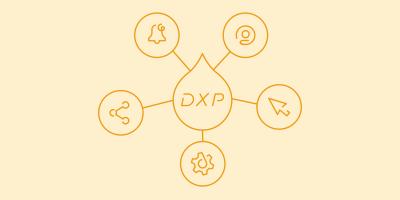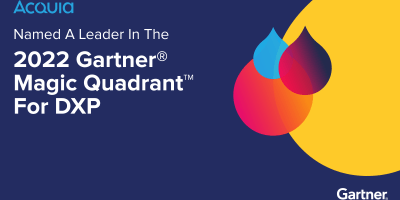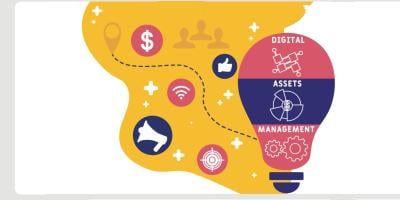Collection
The Benefits of a Digital Experience Platform (DXP)
Collection :
Think of the evolution of technology in your lifetime. I’ve gone from the scream sounds of a dial-up internet connection to telling Alexa to order me laundry detergent I forgot while shopping. We’ve got mobile devices, voice assistants, AR/VR, IoT, digital signage — the list goes on.
Interactions spread across these devices create winding, ongoing digital experiences that make up a considerable amount of what modern humans experience in a day. Businesses have needed to adapt to this digital evolution by making sure their own marketing efforts include as many channels as possible.
That used to be a difficult goal. It used to be a bunch of different technologies responsible for deploying content to different places. Fingers crossed that those technologies played nicely with each other and nothing broke along the way.
Now, we have the digital experience platform (DXP): a set of integrated technologies that allow you to create, manage, and deploy omnichannel experiences to your customers wherever they are. Once deployed, the platform provides insights on your content performance and customer engagement. It can use artificial intelligence (AI) to deliver a unique experience to each customer on the channel they prefer.
Let’s look at the tangible benefits of a DXP and explore how they best facilitate the modern digital experience.
What are the benefits of a DXP?
Increasingly diverse technical media demands continually more from organizations. People want access to information from everywhere, and it’s good business to give people what they want. That means serving omnichannel digital experiences that are consistent, relevant, and enjoyable.
With the number of digital channels on the rise, a DXP addresses the challenge of creating, managing, and publishing those experiences from one place. Here are some DXP pluses:
- Open, composable architecture
- Integrated content and data
- Personalization
- Content creation and management
- 360° customer view
- Governance and compliance
Open, composable architecture
I led off with “open, composable architecture” as a benefit but — full disclosure — it’s actually a requirement in our world of rapid technology change. DXPs are either closed or open systems (more on that in a minute), so you get to choose.
When talking about a composable architecture, Drupal creator and Acquia co-founder Dries Buytaert says it best:
A composable architecture is an architecture in which the individual components of the stack can be replaced without affecting other parts of the system. The idea is to enable organizations to select and assemble a customized solution that best fits their needs.
Composability is part of the DNA of open source software projects like Drupal. Our DXP is built on Drupal, making it a flexible solution. Drupal has 46,000+ modules that allow you to craft your own digital experiences. Because it’s open source, you can even contribute your own modules to meet technology and customer demands unique to your business. That wouldn’t be the case — well, it’d be a lot harder and pricier — with other proprietary or close CMSs.
Composability extends across the DXP solution. It’s integrated into your existing technology stack and process. As demands grow, you can easily leverage other solutions that play well together. An open DXP allows teams across an organization to fashion it exactly as the organization needs.
Designed to be API-first, our solutions play nicely with other technologies your organization uses. What’s more? As your organization grows and your technological needs change, a composable DXP can be rehashed, changed, added to, and subtracted from. Whatever you need, composability allows you to build what you need as you need it.
Integrated content and data
Content should always be driven by a content strategy informed by customer data. A good DXP ensures that the two reside in the same system. The rise in content volume and velocity will continue. Teams developing campaigns need customer data for more targeted campaigns, faster decision-making, and more relevant content across the board. As content is published, it can be monitored and analyzed for efficacy and engagement.
Personalization
We expect content to be tailored to us. Not only in B2C but now in B2B. Customers don’t want generalized mass communication; those will be ignored and forgotten. They need memorable experiences that leave an impression based on their own preferences, which means delivering dynamic and personalized experiences. You can do this at scale with a DXP.
As a single platform that houses customer data, it can analyze data trends across channels to give you a better idea of what to personalize going forward. This data agility supercharges your ability to develop hyper-personalized content by quickly identifying trends as data enters your DXP.
Experience creation for everyone
Gone are the days of marketing teams reliant on developers. With the growth of martech, marketers can now go from idea to publication to any downstream channels with no coding required. A DXP facilitates that because it’s built for collaboration across all teams. With low- and no-code options across a DXP, you don’t need to know how to code to publish digital experiences.
Drive your customer experience with 360° customer profiles
It’s more important than ever to deliver outstanding customer experiences. It’s not enough to focus on a single channel or interaction because customers have both in person and online interactions. To truly deliver, you need a single profile of a customer across all their interactions. This 360° view of customers uses first-party data to create a full profile of each customer that takes into account their user behaviors. This, in turn, makes content personalization possible at a one-to-one level.
With structured 360° customer profiles, machine learning (ML) can be applied to deliver unique experiences. ML models can analyze behaviors and individual interactions to enable predictive marketing — meaning ML models analyze what your customers are doing, predict next moves, and activate marketing campaigns automatically.
Governance, compliance, and privacy
Brand consistency, customer data protection, and compliance standards and laws are crucial to running a digitally responsible organization. Having brand and compliance guardrails in your DXP makes digital control easier to handle and enforce.
With a DXP, you control who in your organization has access to what. You can protect your brand assets, create workflows so no content slips through without being reviewed and approved, and store brand content in a centralized place that approved users can access.
The Acquia DXP difference
Our open DXP is the best answer to delivering digital experiences at scale, innovating your customer experience, elevating your brand, and engaging users. It’s a technology stack that’s built to run from day one and to evolve with your business needs — created for resilience and adaptability so you have the freedom to change.
Mars harnessed the power of a DXP when they built 55 brand sites in 10 months while cutting development time by 20-40% and saving 20% on total combined costs. They saw growth in their future and adapted to building experiences at scale into their brands with the technological help of a DXP. Candy jokes aside, that’s pretty sweet.
What we’ve shown here is from the DXP benefits highlight reel, but seeing it in action is better. Get in touch, and we’ll happily show you how Acquia DXP can make a difference for you and your customers



